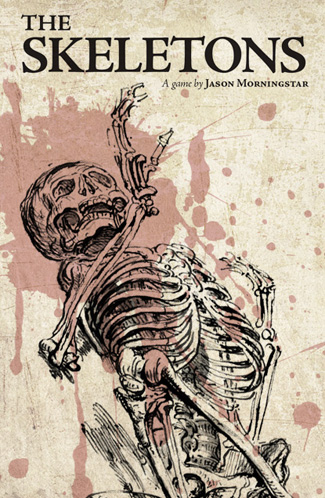The Skeleton Crew
I love a fun roleplaying game, and this is the season to talk about some scary — or at least horror-themed — RPGs. Today, we’re talking about The Skeletons, designed by Jason Morningstar

This is a freeform roleplaying game published by Bully Pulpit Games, which is owned by Morningstar, back in 2016. Morningstar, probably best known for the brilliant “Fiasco,” sometimes described as the Coen Brothers RPG, generally specializes in experimental, educational, and even outright oddball games that don’t need a gamemaster. His specialty is games where you play people on their worst, most trying days. His games feature doomed Civil War soldiers trapped behind enemy lines, professors possessed by otherworldly roaches, child soldiers in World War II Poland, queer Soviet airwomen during WWII, star-crossed lovers, police operatives demoralizing and destroying activist groups… and rabbits. Morningstar’s games can be madcap and hilarious, but they often examine the nature of death, defeat, and tragedy.
So “The Skeletons” is a game for 1-6 players requiring a few hours of playing time and a private space where you could dim the lights or play music. It’s about 60 pages long. It’s not super-complicated.
What’s it about? Well, if you’ve ever playing a standard fantasy RPG, you’ve probably run into a situation where your party of adventurers is exploring a dungeon and comes across an ancient tomb filled with treasures, but to get the goodies, you have to battle the undead horrors guarding the crypt.
In this game, you don’t play the bold adventurers, swinging your sword and casting your spells. You play the skeletons.
In fact, you play cursed skeletons, stripped of memories and identities by a powerful wizard. You are dead, fully inanimate and insentient, until someone enters the tomb. When that happens, you rise, lift your weapons, and attack, seeking to drive the defilers from the crypt. During the brief periods when you’re active, you can think, you can feel, you can try to remember your past — but you can’t escape. And when you’ve driven out or killed the adventurers, you return to your inert state.
And the years pass. The centuries pass. The millennia pass.
The players begin by choosing their character — either a simple human skeleton wielding a sword or axe or bow, or some sort of unusual skeleton — a headless corpse, a nonhuman race, a fully inhuman monster.
You can personalize each skeleton as you please, and each character sheet includes questions you can potentially ask to help recover your own memories.
After that, all the players collaborate to determine what the tomb looks like, how it’s decorated, what treasures it contains.
And then the lights are switched off briefly. And when the lights come back on, it’s time for the skeletons to fight off their first tomb robbers. Once they’ve been driven off or killed (the outcome is never in doubt — the game isn’t about combat, and the skeletons won’t crumble for eons) and once the skeletons have had a few brief moments to ponder their forgotten lives, they return to their alcoves and their dreamless slumber.
The tomb and even the skeletons themselves are altered as the eons grind past. Walls can crack, sarcophagi can split open, metal tarnishes, cloth decays. Skeletons can lose bones, their weapons can warp, even the enchantments animating them can fade. The tables for these effects are particularly evocative: Glory Fades, Worlds Crumble, Time Devours, and Gods Laugh.
In time, however, even these deathless skeletons will fall. They will be defeated, their bones scattered, their tomb ransacked, and their consciousness sinking into the darkness one final time.
Verdict: Thumbs up. Is it horror? I think it certainly is. It’s not just that you’re playing the cursed undead, doomed to spend eternity fighting to protect a long-dead wizard’s Man Cave. There’s also the horror of the slow passage of deep time — the fact that every time you awaken, centuries can pass, with the world around you drastically changed, with the knowledge that your loved ones — who you may eventually remember — are long gone, that your own ancestors are likely dead, that you can only realize this for brief periods before you’re forced back down into the blackness for another few thousand years.
But it’s also something that transcends horror, too. The slow uncovering of your memories — What’s your name? Who did you love? Who were your rivals and friends? How did you die? What were your triumphs? — creates a game with a strong theme of loss, melancholy, and sorrow, but also a sense that there are some things that are timeless, and that death, though worth fighting against, can eventually become something to be embraced.
If you and your friends are getting bored with dungeon crawls with your murder hobos, take a break to give them a look at how the other half died.
Comments off
